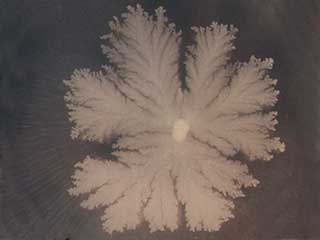1. Record a digital image of the colony with a digital camera or scanner. It may look something like Figure .
 |
2. Using the Fractal Dimension program, find the dimension of the colony. How does the dimension vary as nutrient concentration varies in the plates? Measure both the global dimension of the aggregate (the dimension of the entire colony including the interior), and the surface fractal dimension (the fractal dimension of the edge of the colony).
How does the global dimension compare with that of a diffusion-limited
aggregate (DLA)?
How does the surface dimension compare with that expected from a random
walk? Compare the dimension obtained with that found in HandsOn 5.1.
If the dimension differs from that of a random walker model, does it behave
as you would expect with bacteria that are socially cooperative? Write a short
paragraph explaining why, or why not.
3. Plot the radius of the aggregate versus time and find the growth velocity.
Is this also a function of nutrient level?
4. Is the growth of the colony limited by diffusion of nutrients? Suppose
that a nutrient molecule moves an average distance r in a time t according
to the diffusion law: r2 = 4Dt where D, called the diffusion
constant, has the approximate value 10-6 cm2/sec.
On average how far can a nutrient molecule diffuse in one hour? One day?
How does that compare to the initial and final growth velocities you observed
for the bacterial colony?
5. How do you interpret your results for the plate you inoculated at two points
0.5 centimeter apart? Is it consistent with a model in which access to nutrients
is controlled by diffusion? What about the growth pattern on the plate inoculated
at two points 1 centimeter apart? Can you simulate this experiment using the
Aggregation program?